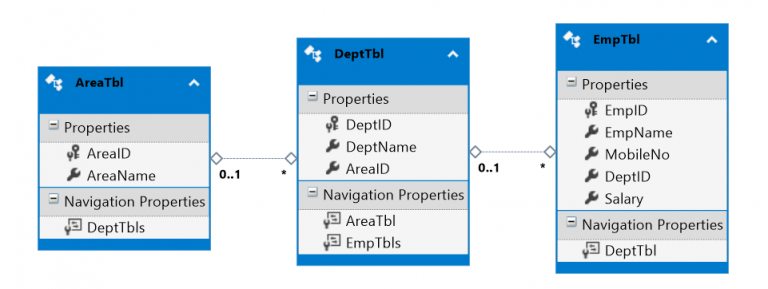

- Getorgchart application using ef database first install#
- Getorgchart application using ef database first update#
- Getorgchart application using ef database first code#
See the below code where we have done this thing. We can reduce the calling to the database to just a single time by storing the result in a list type object and then subsiquently fetching a record from there. Var empmatt = (e => e.Name = "Matt").FirstOrDefault() See the below code where EF Core will be making database call 2 times. We can make use of List type to store the result set and then extact the data from it, instead of making calls to the database again and again.

Whenever we access an entity through database context then Entity Framework Core calls the database to fetch the result set. We can use it in our code like shown below. The AsNoTracking method tells EF Core not to track the entity.

This will cause unnecessary burden when we don’t require tracking particularly in read-only scenarios. We can perform the optimization of Entity Framework codes in 3 manners which are:Įntity Framework Core keeps track of all the entities that are returned from a LINQ query. It is necessary that we Optimize our Entity Framework Core code so that the application codes remain light and at the same time execute faster. On putting a breakpoint over deptName variable we can see it’s value. In the above code the Department which is related to Employee entity is lazy loaded.
Getorgchart application using ef database first install#
Install the package and enable it with a call to UseLazyLoadingProxies method in the OnConfiguring method of Database Context file. In order to use Lazy Loading we must do 2 things: However, when the first time we access a navigation property, the data required for that navigation property is automatically retrieved. In Entity Framework Core Lazy Loading technique the related data isn’t retrieved when the entity is first read. The below code will only load the Department having name as ‘Admin’. await context.Entry(emp).Reference(s => s.Department).Query().Where(s => s.Name = "Admin").LoadAsync() For this use the Query() method as shown below. We can also filter the related data before loading them. The Reference property gets the reference to the related data and the LoadAsync() method loads it explicitly.

The code – await context.Entry(emp).Reference(s => s.Department).LoadAsync() loads the related entity called Department of the Employee entity. Var emp = await (e => e.Name = "Matt")Īwait context.Entry(emp).Reference(s => s.Department).LoadAsync() Then the following Include code loads the Department & Project entities of the Employee. For example, suppose the Employee entity also has another related entity called Project. We can use multiple Include() methods to load multiple levels of related entities with Entity Framework Core. The Include() method will execute a single SQL Join Query on the database to fetch the data.
Getorgchart application using ef database first update#
It should be noted that Entity Framework Core executes SQL Queries behind the scene to read, create, delete and update data. We will find the value of Department property is filled with value this time. Execute SQL Stored Procedures using FromSqlRaw() & ExecuteSqlRawAsync() methods in Entity Framework CoreĮmployee emp = await (e => e.Name = "Matt")Ĭheck the above code by putting a breakpoint over it in Visual Studio and note the value of emp variable. Execute Raw SQL Queries using FromSqlRaw() method in Entity Framework Core Configure Many-to-Many relationship using Fluent API in Entity Framework Core Configure One-to-One relationship using Fluent API in Entity Framework Core Configure One-to-Many relationship using Fluent API in Entity Framework Core Code-First Approach in Entity Framework Core Database-First approach in Entity Framework Core This tutorial is a part of Entity Framework Core series.


 0 kommentar(er)
0 kommentar(er)
